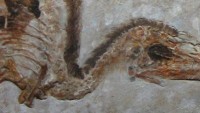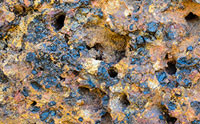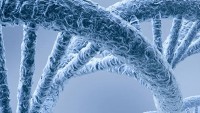By Dr. Andreas J. Köstenberger Can we know the exact date of Christ’s death? …read more Read more here: AIG Daily
By Ken Ham With the Ark Encounter opening on July 7 in Northern Kentucky, many of the visitors will encounter the concept of animal kinds, perhaps for the first time. Kind is the biblical term used to refer to groups of living things. All organisms reproduce “according to their kind” (Genesis 1:11–12, 21, 24–25). In most instances, research has placed kind around the same level as family in our modern classification system. Now Ark Encounter visitors unfamiliar with this concept might be surprised to learn that Noah took only around 2,000 animal kinds with him on the Ark—not millions of [More]
By Creation Moments When you look in a mirror you are conscious of seeing yourself. Bottlenose dolphins, elephants and primates in general have also shown this ability, but that’s about it. read more …read more Read more here: Creation Moments
By Ken Ham They urge “educators and legislators to reject all policies that condition children to accept as normal a life of chemical and surgical impersonation of the opposite sex. Facts—not ideology—determine reality.” They go on to give eight reasons why gender ideology harms children. They argue that conditioning children to accept that being transgender is normal and healthy is “child abuse” and that “a person’s belief that he or she is something they are not is, at best, a sign of confused thinking.” Gender ideology does harm children because it teaches them something that goes completely against God’s good [More]
By Dr. Elizabeth Mitchell Evolutionary scientists think birds evolved from dinosaurs and to help prove it, they’ve engineered a chicken embryo to grow a dinosaur-like lower leg. …read more Read more here: AIG Daily
Evidence of God’s creative craftsmanship is even found in the very words of Scripture. …read more Read more here: creation.com
By Multimedia On this episode of ID The Future, host David Boze interviews filmmaker Fred Foote, writer and producer of the new feature-length drama Alleged, which seeks to tell the real story behind the infamous 1925 Scopes Trial in Dayton, Tennessee that pitched Darwinian evolution against belief in God. After seeing the 1960 film Inherit the Wind, starring Gene Kelly and Spencer Tracy, Foote did his own research into the trial and discovered that Inherit the Wind was “almost exactly wrong” on many crucial points. So he set out to make another movie that would set the record straight and [More]
By Ken Ham Well, my friend Buddy Davis—a singer, songwriter, dinosaur sculptor, workshop leader, and so much more—recently received the following testimony: I just wanted to write to say thank you for your ministry! Your songs have taught our family for years, and have been a great way to share the truth of God’s creation! I also wanted to tell you that one of our daughters accepted Christ as her savior a while back, and God used one of your songs (“Come to Me Little Children”) to touch her heart, and bring her to realize she needed a savior! <a [More]
By Roger Patterson With a bumper crop of ostensibly Christian films at the box office this spring, God’s Not Dead 2 has made an impact. …read more Read more here: AIG Daily
By Multimedia On this episode of ID the Future, Casey Luskin continues his talk with Dr. Cornelius Hunter, who recently signed up to take an online college-level course on evolution. Dr. Hunter discusses the dogmatic arguments for Darwinian evolution that he encountered and his experience dialoguing with fellow students. Your browser does not support playing Audio, please upgrade your browser or find our podcast on podOmatic Download Episode …read more Read more here: id the future
By Creation Moments Countless television programs, museums, textbooks, and popular articles tell us that the birds evolved from dinosaurs. It now appears that this claim is even less credible! read more …read more Read more here: Creation Moments
One way that our supporters can leave a lasting legacy, and even save on taxes, is by giving a home or other residential property to Answers in Genesis. …read more Read more here: AIG Daily
By Multimedia On this episode of ID the Future, Biologic Institute director Dr. Douglas Axe discusses his contribution to the book Science and Human Origins. How efficient is the Darwinian mechanism at inventing new things? Could it really be responsible for the development of human beings, as Darwinists claim? Axe reviews his recent studies on mutation rates and the ability of Darwinian evolution to create new proteins. Tune in and discover what he found out! Your browser does not support playing Audio, please upgrade your browser or find our podcast on podOmatic Download Episode …read more Read more here: id [More]
By Multimedia On this episode of ID the Future, Casey Luskin sits down with CSC Fellow Dr. Cornelius Hunter, who recently signed up to take a free online course at Coursera titled “Introduction to Genetics and Evolution,” taught by Duke University professor Mohamed Noor. Tune in as Dr. Hunter shares about his experience & discusses the misrepresentations and fallacies that are presented in the typical undergraduate evolutionary biology course. Your browser does not support playing Audio, please upgrade your browser or find our podcast on podOmatic Download Episode …read more Read more here: id the future
By Ken Ham Image from “Genocide & Incest Park,” IndieGoGo. Regarding this billboard, the op-ed states, Jim Helton, president of the 1,300-member group, warns that “while they have a legal right to celebrate their mythology, we find it immoral and highly inappropriate as family entertainment.” Oh where to begin? Positive note: these atheists welcomed the term “immorality” into their vocabulary. Negative: atheists exegeting Bible stories are bound to miss major points. Of all the things to protest as immoral in our day, it is wildly off-target to pick on a Bible story meant to teach what happens to people when [More]
What happens when a soil fungus runs into a hard mineral containing precious trace amounts of nutritious iron? A poorly designed fungus might go hungry and languish like a forlorn noodle, but researchers recently found ways that a soil fungus conducts a miniature mining operation. More… …read more Read more here: icr.org
By Dr. Kevin Anderson Evolutionists conclude “the birth of new genes is an important motor of evolutionary innovation,” but how are new genes made? …read more Read more here: AIG Daily
By Multimedia On this episode of ID the Future, the CSC’s Dr. Paul Nelson talks with Dr. Wolf-Ekkehard Lönnig, retired geneticist at the Max Planck Institute for Plant Breeding Research in Germany, about randomness in natural selection and why randomness is such a controversial topic. Your browser does not support playing Audio, please upgrade your browser or find our podcast on podOmatic Download Episode …read more Read more here: id the future
By Avery Foley As Christians we must reject the view that nature should be revered above the well-being of mankind, but what is the proper response toward Creation? …read more Read more here: AIG Daily
By Ken Ham This school district, like many others, allows the Gideons to make Bibles available to students. After a complaint from a parent, FFRF and another secular group have been trying to get the school to ban the distribution of Bibles. And their tactic has been to hand out their own atheistic literature as well as satanic pamphlets! The school, which says it can’t discriminate on the type of literature being given out, hasn’t made a decision on whether to change its policy or not. Although the group’s name is the “Freedom From Religion Foundation,” it’s really not religion [More]
By Ken Ham The author bemoans the popularity of intelligent design and the statistic that “more than a third of people in [the UK and US] reject the theory of evolution outright or believe that it is guided by a supreme being.” This secularist is quite upset that her religion of atheistic naturalism does not reign supreme. She says that, “It is critical that the voting public have a clear understanding of evolution. Adaptation by natural selection, the primary mechanism of evolution, underpins a raft of current social concerns such as antibiotic resistance, the impact of climate change and …read [More]
By Creation Moments We were once told that tool use is what separates man from the animals. Then it was discovered that some animals use tools. Now scientists have learned that these animals do more than just grab something from their surroundings; they look for something that would be needed to do the job. read more …read more Read more here: Creation Moments
By Ken Ham Of course, this policy is against the teachings of God’s Word. Here is a list of Scriptures that I think Target needs to consider: Have you not read that He who made them at the beginning “made them male and female”? (Matthew 19:4) But from the beginning of the creation, God “made them male and female.” (Mark 10:6) God created man in His own image; in the image of God He created him; male and female He created them. Then God blessed them, and God said to them, “Be fruitful and multiply; fill the earth and subdue [More]
If you would like to partner with us in spreading Christ’s soul-saving message, there are several ways that you can do this through planned giving. …read more Read more here: AIG Daily
By Dr. David Menton Every human being has the ability to communicate with a range of expressions no other creature can match. …read more Read more here: AIG Daily
By Creation Moments When one thinks of clever creatures, moths are probably not the first creature that come to mind – in fact, they probably don’t come to mind at all! read more …read more Read more here: Creation Moments
By Ken Ham “Why the Bible Is True” is a large exhibit. The storyline will follow three college students around their campus. …read more Read more here: AIG Daily





























